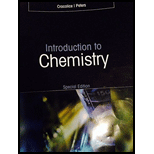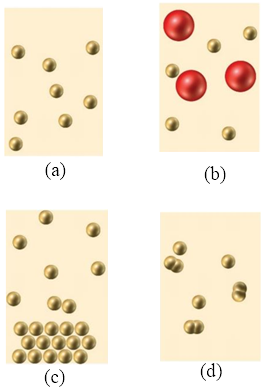
Introduction to Chemistry, Special Edition
6th Edition
ISBN: 9781337035934
Author: Cracolice/Peters
Publisher: Cengage Learning
expand_more
expand_more
format_list_bulleted
Concept explainers
Textbook Question
Chapter 2, Problem 21E
Which of the following particulate illustrations represent pure substances and which represent mixtures?

Expert Solution & Answer
Trending nowThis is a popular solution!

Students have asked these similar questions
Which of the following is a homogeneous mixture? a) water and sand b) water and salt c) water and cooking oil d) a hard-boiled egg
I NEED A HELP WITH THIS
Give the meaning of the following in an essay form.
Compound:
Mixture:
Pure Substance:
Element::
Matter:
Chapter 2 Solutions
Introduction to Chemistry, Special Edition
Ch. 2 - Consider the photograph and illustrations of table...Ch. 2 - In the left box, draw a particulate-level...Ch. 2 - Classify the following changes as chemical C or...Ch. 2 - Specific gravity is a physical property. Beakers...Ch. 2 - Classify the following as homogenous or...Ch. 2 - Table salt from the beaker on the left in the...Ch. 2 - Which of the following are compounds, and which...Ch. 2 - Prob. 2.8TCCh. 2 - Identify the net electrical force-attraction,...Ch. 2 - aIs the process of boiling water exothermic or...
Ch. 2 - In everyday language, the term conserve usually...Ch. 2 - Write a brief description of the relationships...Ch. 2 - Write a brief description of the relationships...Ch. 2 - Prob. 3CLECh. 2 - Write a brief description of the relationships...Ch. 2 - Prob. 5CLECh. 2 - Prob. 6CLECh. 2 - Prob. 1ECh. 2 - Classify each of the following as macroscopic,...Ch. 2 - Suggest a reason for studying matter at the...Ch. 2 - How does a chemist think about particles that are...Ch. 2 - Using spheres to represent individual atoms,...Ch. 2 - Describe a piece of ice at the particulate level....Ch. 2 - 7.The word pour is commonly used in reference to...Ch. 2 - Prob. 8ECh. 2 - Which of the three states of matter is most easily...Ch. 2 - Compare the volumes occupied by the same sample of...Ch. 2 - Classify each of the following properties as...Ch. 2 - Classify the italicized property as chemical or...Ch. 2 - Which among the following are physical changes? a...Ch. 2 - Classify each of the following changes as chemical...Ch. 2 - Is the change illustrated below a physical change...Ch. 2 - Is the change in the illustration below a physical...Ch. 2 - Diamonds and graphite are two forms of carbon....Ch. 2 - Aspirin is a pure substance. If you had the choice...Ch. 2 - The substance in the glass below is from a kitchen...Ch. 2 - Are the contents of the bottle in the picture...Ch. 2 - Which of the following particulate illustrations...Ch. 2 - Which of the following particulate illustrations...Ch. 2 - Which of the following are pure substances and...Ch. 2 - Which of the substances below are pure and which...Ch. 2 - Apart from food, list five things in your home...Ch. 2 - Can the terms homogeneous and heterogeneous be...Ch. 2 - Which items in the following list are...Ch. 2 - Classify each of the following mixtures as either...Ch. 2 - Some ice cubes are homogeneous and some are...Ch. 2 - The freshly polished brass cylinder in the picture...Ch. 2 - Draw a particulate-level sketch of a heterogeneous...Ch. 2 - Draw a particulate-level sketch of a homogeneous...Ch. 2 - Suppose someone emptied ball bearings into a...Ch. 2 - Suggest at least two ways to separate ball...Ch. 2 - Prob. 35ECh. 2 - You receive a mixture of table salt and sand and...Ch. 2 - Classify the following as compounds or elements: a...Ch. 2 - Classify each of the following pure substances as...Ch. 2 - Which of the following are elements, and which are...Ch. 2 - Classify each of the following pure substances as...Ch. 2 - Classify each substance in the illustrations below...Ch. 2 - Does each of the particulate-level models below...Ch. 2 - a Which of the following substances would you...Ch. 2 - a Which of the following substances would you...Ch. 2 - Metal A dissolves in nitric acid solution. You can...Ch. 2 - A white, crystalline material that looks like...Ch. 2 - Questions 47 and 48: Samples of matter may be...Ch. 2 - Questions 47 and 48: Samples of matter may be...Ch. 2 - What is the main difference between electrostatic...Ch. 2 - Identify the net electrostatic force attraction,...Ch. 2 - Identify the reactants and products in the...Ch. 2 - In the following equation for a chemical reaction,...Ch. 2 - In the equation Ni+Cu(NO3)2Ni(NO3)2+Cu, which of...Ch. 2 - Write the formulas of the elements that are...Ch. 2 - Prob. 55ECh. 2 - Classify each of the following changes as...Ch. 2 - As a child plays on a swing, at what point in her...Ch. 2 - A bicycle accelerates from 5 miles per hour to 15...Ch. 2 - After solid limestone is heated, the rock that...Ch. 2 - Before electronic flashes were commonly used in...Ch. 2 - The photograph below shows a beaker of water and a...Ch. 2 - Prob. 62ECh. 2 - Prob. 63ECh. 2 - Prob. 64ECh. 2 - Distinguish precisely and in scientific terms the...Ch. 2 - Prob. 66ECh. 2 - A natural-food store advertises that no chemicals...Ch. 2 - Prob. 68ECh. 2 - Name some pure substances you have used today.Ch. 2 - How many homogeneous substances can you reach...Ch. 2 - Which of the following can be pure substances:...Ch. 2 - Can you have a mixture of two elements as well as...Ch. 2 - Can you have more than one compound made of the...Ch. 2 - Rainwater comes from the oceans. Is rainwater more...Ch. 2 - Prob. 75ECh. 2 - Prob. 76ECh. 2 - Consider the sample of matter in the illustration...Ch. 2 - A particulate-level illustration of the reaction...Ch. 2 - Prob. 79ECh. 2 - Prob. 80ECh. 2 - Prob. 81ECh. 2 - Prob. 82ECh. 2 - Particles in the illustration below undergo a...Ch. 2 - Prob. 84E
Knowledge Booster
Learn more about
Need a deep-dive on the concept behind this application? Look no further. Learn more about this topic, chemistry and related others by exploring similar questions and additional content below.Similar questions
- Which of the following are elements, and which are compounds? a NaOH; b BaCl2; c He; d Ag; e Fe2O3.arrow_forwardWhich of the substances below are pure and which are mixtures? Which could be either? Explain your answers.arrow_forwardClassify the substances represented by the models in problem 1-57 as to the type of pure substance, that is, as element or compound.arrow_forward
- Which of the following are the same and which are different? a. a substance and a pure substance b. a heterogeneous mixture and a solution c. a substance and a mixture d. a homogeneous mixture and a solutionarrow_forwardA solution made by dissolving sugar in water is homogeneous because the composition is the same everywhere. But if you could look with very high magnification, you would see locations with water particles and other locations with particles of sugar. How can we say that a sugar solution is homogenous?arrow_forwardDraw a particulate-level sketch of a heterogeneous pure substance.arrow_forward
- Using spheres to represent individual atoms, sketch particulate illustrations of a substance as it is heated from the solid to the liquid and to the gaseous state.arrow_forwardWhat properties distinguish solids from liquids? Liquids from gases? Solids from gases?arrow_forwardA cup of coffee is an example of: a. a liquid pure substance b. a gaseous mixture c. a solid pure substance d. a liquid mixture e. a solid mixturearrow_forward
- Which of the following are pure substances and which are mixtures: a table salt; b tap water; c clean, dry air; d steam.arrow_forward1.82 Which of the following molecular-scale diagrams best represents a pure compound? Explain your answer.arrow_forwardYou receive a mixture of table salt and sand and have to separate the mixture into pure substances. Explain how you would carry out this task. Is your method based on physical or chemical properties? Explain.arrow_forward
arrow_back_ios
SEE MORE QUESTIONS
arrow_forward_ios
Recommended textbooks for you
 Introductory Chemistry: An Active Learning Approa...ChemistryISBN:9781305079250Author:Mark S. Cracolice, Ed PetersPublisher:Cengage Learning
Introductory Chemistry: An Active Learning Approa...ChemistryISBN:9781305079250Author:Mark S. Cracolice, Ed PetersPublisher:Cengage Learning Chemistry for Engineering StudentsChemistryISBN:9781337398909Author:Lawrence S. Brown, Tom HolmePublisher:Cengage LearningChemistry: Matter and ChangeChemistryISBN:9780078746376Author:Dinah Zike, Laurel Dingrando, Nicholas Hainen, Cheryl WistromPublisher:Glencoe/McGraw-Hill School Pub Co
Chemistry for Engineering StudentsChemistryISBN:9781337398909Author:Lawrence S. Brown, Tom HolmePublisher:Cengage LearningChemistry: Matter and ChangeChemistryISBN:9780078746376Author:Dinah Zike, Laurel Dingrando, Nicholas Hainen, Cheryl WistromPublisher:Glencoe/McGraw-Hill School Pub Co
 Chemistry by OpenStax (2015-05-04)ChemistryISBN:9781938168390Author:Klaus Theopold, Richard H Langley, Paul Flowers, William R. Robinson, Mark BlaserPublisher:OpenStax
Chemistry by OpenStax (2015-05-04)ChemistryISBN:9781938168390Author:Klaus Theopold, Richard H Langley, Paul Flowers, William R. Robinson, Mark BlaserPublisher:OpenStax General, Organic, and Biological ChemistryChemistryISBN:9781285853918Author:H. Stephen StokerPublisher:Cengage Learning
General, Organic, and Biological ChemistryChemistryISBN:9781285853918Author:H. Stephen StokerPublisher:Cengage Learning

Introductory Chemistry: An Active Learning Approa...
Chemistry
ISBN:9781305079250
Author:Mark S. Cracolice, Ed Peters
Publisher:Cengage Learning

Chemistry for Engineering Students
Chemistry
ISBN:9781337398909
Author:Lawrence S. Brown, Tom Holme
Publisher:Cengage Learning

Chemistry: Matter and Change
Chemistry
ISBN:9780078746376
Author:Dinah Zike, Laurel Dingrando, Nicholas Hainen, Cheryl Wistrom
Publisher:Glencoe/McGraw-Hill School Pub Co


Chemistry by OpenStax (2015-05-04)
Chemistry
ISBN:9781938168390
Author:Klaus Theopold, Richard H Langley, Paul Flowers, William R. Robinson, Mark Blaser
Publisher:OpenStax

General, Organic, and Biological Chemistry
Chemistry
ISBN:9781285853918
Author:H. Stephen Stoker
Publisher:Cengage Learning
Types of Matter: Elements, Compounds and Mixtures; Author: Professor Dave Explains;https://www.youtube.com/watch?v=dggHWvFJ8Xs;License: Standard YouTube License, CC-BY